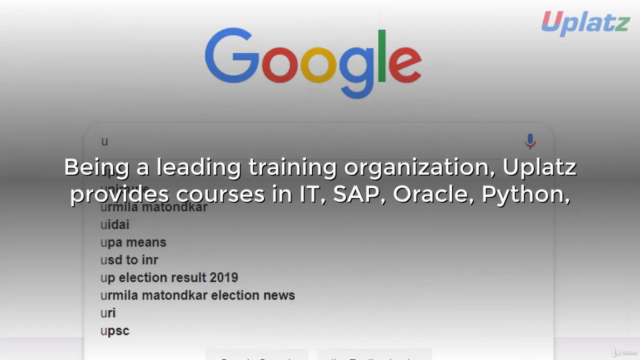SAP Controlling (CO) Certification Training
Learn concepts of SAP CO module in depth. Master SAP Controlling with practical scenarios. Become an SAP CO Consultant.
2.65 (114 reviews)

1 916
students
5 hours
content
Sep 2021
last update
$34.99
regular price
Why take this course?
- Internal Orders:
- Use of Internal Order Types (f): Internal orders are used to control and record internal services, products, or materials consumed within the company. Different types of internal orders (e.g., production, service, material) can be defined based on the requirements.
- Settlement Profile (a): Determines how internal orders are settled. It includes settings for cost collection, billing method, and settlement rules.
- Planning Profile (c): Used to enter planned data for internal orders which are later compared against actual consumption.
- Budget Profile (d): Allows for budget planning for internal orders, which can be used for internal cost control and comparison with actual costs.
- Tolerance for Budgeting and availability control (e): Defines the tolerance levels for budgeted amounts against actual consumption or availability of resources.
- Order Types (f): Differentiates between real orders (actual consumption) and statistical orders (for planning purposes).
- Real Orders and statistical Orders (g): Real orders are consumed and have a direct impact on costs, while statistical orders are for planning and forecasting.
- Creation of secondary cost elements for Internal and External settlement (h): Allows for the creation of secondary cost elements that can be used for more detailed cost tracking within internal orders.
- Planning for Internal Orders (i): Enables planning entries for internal orders which can be used for budgeting and controlling purposes.
- Entering Budget Information (j): Provides the ability to enter budgeted costs for internal orders, which will be used later for variance analysis.
- Actual Data posting (k): Allows for the posting of actual consumption data against planned data.
- Displaying Internal Order information (l), Displaying Budget control availability (m): These transactions provide a detailed view of internal orders and their relationship to budgeted amounts.
- Settlement of Real Internal Orders to Cost Centers (r): Real internal orders can be settled directly to cost centers, reflecting the actual consumption of resources.
- Profit Center Accounting:
- Basic settings for Profit Center Accounting (a): Configures the general parameters and settings required for profit center accounting within the organization.
- Creation of Profit Centers (b): Defines the organizational units that will be used as profit centers for accounting purposes.
- Maintenance of control Parameters for Actual Postings (c): Sets up the parameters that govern how transactions are posted to profit centers.
- Maintaining planning versions for profit centers (d), Maintaining the number ranges for profit center documents (e): These steps involve setting up the necessary data structures and sequential numbers for recording transactions against profit centers.
- Creation of profit center master records (f), Display of profit center master records (g): Establishes the master data for each profit center, including detailed information about its operations.
- Automatic Assignment of Revenue elements for Profit Centers (h): Configures the automatic assignment of revenue recognition elements to profit centers based on certain criteria or rules.
- Assignment of profit centers in cost center master records (i): Links profit centers with cost centers, allowing for consolidated accounting and analysis.
- Creation of account groups in profit center accounting for planning (j), Planning for profit and loss account items (k), Planning for balance sheet items (l): Sets up planning structures and account groups that will be used for budgeting and forecasting within the profit centers.
- Posting of transactions into profit centers (m): Records financial transactions directly against the profit center, reflecting revenue and expense flows.
- Generating the variance reports for profit and loss account items (n), Generating the variance reports for balance sheet items (o): Produces reports that show differences between planned and actual figures for both profit and loss and balance sheet accounts.
- Derivation rules creation for revenue elements (p), Derivation rules creation for Balance Sheet accounts (q): Defines the logic and rules by which revenue and expense postings are recognized in the profit center accounting.
- Cost Center Accounting:
- Creation of Cost Centers: Defines the organizational units that are accountable for costs but not directly involved in revenue-generating activities.
- Settlement to Cost Centers: Posts costs from internal orders, projects, or other cost units to the respective cost centers.
- Order Management: Handles the creation, change, and deletion of orders within the system.
- Controlling Area Configuration: Sets up the controlling area where a cost center is located, defining the accounting principles and rules that apply.
- Material Ledger:
- Activation of Material Ledger (e): Enables the material ledger feature to track additional account assignments for materials.
- Assignment of Currency Types to Material Ledger Type (b): Assigns different currency types to the material ledger for multi-currency transactions.
- Assignment of Material Ledger Types to Valuation Area (c): Links material ledger types with specific valuation areas for detailed tracking and reporting.
- Maintain Number Ranges for Material Ledger Documents (d): Sets up the sequential number ranges used in documenting transactions within the material ledger.
- Activation of Actual Costing (e): Enables the actual costing feature, which tracks and accumulates actual costs directly related to materials.
- Assignment of Accounts for Automatic Posting (f): Configures automatic posting of material-related transactions to specific accounts in the ledger.
These are the core components of Order Management (especially Internal Orders), Profit Center Accounting, Cost Center Accounting, and Material Ledger within SAP ERP system. Each of these components plays a crucial role in financial accounting, providing detailed insights into internal operations and financial performance.
Course Gallery




Loading charts...
Related Topics
2630068
udemy ID
29/10/2019
course created date
31/10/2019
course indexed date
Bot
course submited by